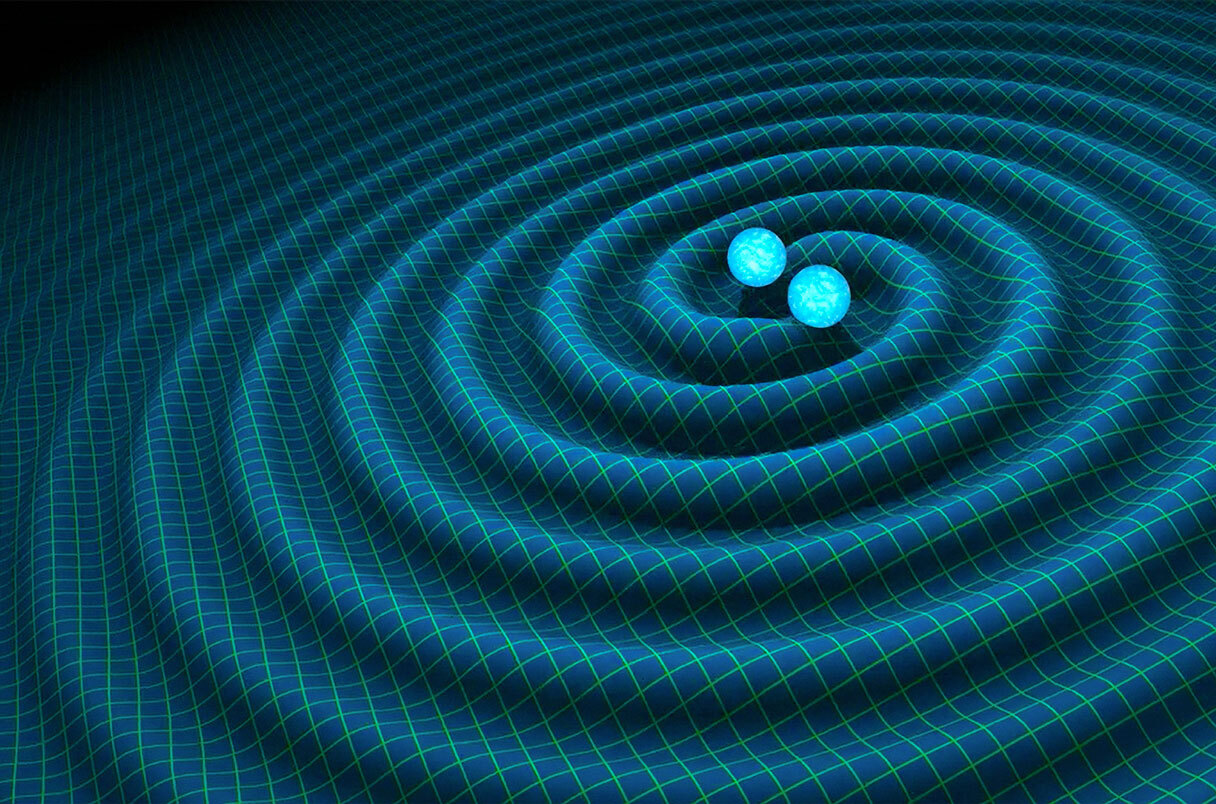20.11.2025
Astronomers approach unusual observation with caution and excitement

As two ultradense astrophysical objects whirl into each other, they radiate a spiral pattern of gravitational waves.R. HURT/CALIFORNIA INSTITUTE OF TECHNOLOGY
It’s a long shot, but scientists may have spotted exotic primordial black holes formed just after the Big Bang. The hints come from the Laser Interferometer Gravitational-Wave Observatory (LIGO) and its European counterpart, Virgo, which sense the tiny ripples in space itself created when massive objects such as black holes whirl together and merge. On 12 November, LIGO and Virgo issued an automated alert for a merger in which at least one object was too light to be an ordinary black hole or neutron star formed in the collapse of a star.
“If this turns out to be real, then it’s enormous,” says Djuna Croon, an astro-particle theorist at Durham University who was not involved in the observation. “This is not an event we can explain by conventional astrophysical processes.” However, the supposed signal could be detector noise, notes Christopher Berry, a gravitational wave astronomer and LIGO member at the University of Glasgow, who shared the alert on Bluesky within hours of the detection. “You might want to bet against” the signal being real, he says. “But it’s fun to speculate.”
As two black holes or neutron stars spiral into each other, they churn up ripples in space called gravitational waves. Detecting the tiny disturbances requires huge instruments. LIGO consists of two L-shaped optical interferometers in Louisiana and Washington state, each with 4-kilometer arms within which laser light resonates. Virgo, in Italy, has 3-kilometer arms. A passing wave stretches one arm more than the other, so light from the two arms interferes and leaks out of the instrument in a signal that waxes and wanes in sync with the wave.
Since 2015, LIGO and Virgo have spotted more than 300 events. Ninety-nine percent of them have been black hole mergers, and a couple have been neutron star mergers. All involved objects with masses greater than that of the Sun—1 solar mass. Neutron stars weigh between 1.1 and 2.2 solar masses, and black holes born of collapsing stars are heavier than that, sometimes weighing as much as dozens of Suns.
However, the new alert indicates at least one of the two merging objects weighed less than 1 solar mass. As Berry wrote on Bluesky, “If this merger is verified it could amount to smoking gun evidence of a population of primordial black holes.”
That’s a big “if.” For each alert, LIGO and Virgo provide a false alarm rate that estimates how often detector noise alone might produce a spurious signal of that size. For this alert the false alarm rate was once every 6.2 years, later revised to once every 4 years. That rate would be fine for an ordinary black hole merger, as they show up at a rate of one every few days, Berry says. But for a rare event that could rewrite textbooks, it’s uncomfortably high, he says.
The case for primordial black holes is tricky, too. They would have formed when dense spots in the newborn universe collapsed under their own gravity and, in principle, could have any mass. Some scientists have long suggested primordial black holes could account for the universe’s invisible dark matter. But if lots of the orbs are floating around, occasionally one should pass in front of a star and, through its gravity, briefly magnify the star. Astronomers have not seen the effect, which limits the numbers of primordial black holes and rules them out as the sole source of dark matter, Croon says.
The merging objects might also be neutron stars, albeit weird ones. Ordinary neutron stars form in the collapse of stars too light to form black holes but still several times heavier than the Sun. Theorists have dreamt up scenarios that might produce lighter neutron stars, notes Emanuele Berti, a theoretical astrophysicist at Johns Hopkins University. For example, while collapsing to a black hole, a very large star might briefly form ring of matter that spawns mini–neutron stars like baubles on a bracelet. But such a model is highly contrived, Berti says. “It’s almost as speculative as primordial black holes.”
No other known astrophysical objects could produce the signal, researchers say. Take white dwarfs, the burned out remains of modest stars like the Sun. Each white dwarf is thousands of kilometers wide, so a pair of them would touch and merge while swirling at a frequency lower than LIGO and Virgo can sense.
LIGO and Virgo issued the alert so astronomers could search for an explosion that might have accompanied it. Such fireworks would require matter and point to neutron stars as the source. However, LIGO and Virgo located the source only to within a sky region 6000 times the size of the Moon, likely rendering that search futile.
However, researchers might be able to determine the nature of the source from the gravitational wave signal alone, says Alexander Nitz, a gravitational wave astronomer at Syracuse University and former LIGO member. A typical black hole merger produces a crash like a thunderclap, but low-mass objects spiraling together hum for minutes or hours. The precise nature of that hum would differ slightly for neutron stars, which would exert tidal forces on each other that black holes would not. “We can actually measure, is this really neutron stars or is this really black holes?” Nitz says.
What would confirm the event is real is spotting more like it, researchers say. “When you see the first candidate of anything you’re always very skeptical,” Berti says. “But when you start seeing whole families of things, then you’re much more confident.” Even then, this marginal signal could remain an enigma, Croon says. “It seems unlikely that we’ll actually know with certainty whether this alert was real or not.”
Quelle: AAAS
